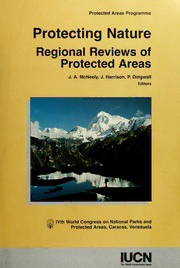
Protecting Nature: regional reviews of protected areas PDF
Preview Protecting Nature: regional reviews of protected areas
Protected Areas Programme Protecting Nature Regional Reviews of Protected Areas J. A. McNeely, J. Harrison, P. Dingwall Editors IVth World Congress on National Parks and Protected Areas, Caracas, Venezuela lUCN TheWorldConservationUnion Aj/M^3^7_ li.cr^ 'I'^V LfCP^'^v" Wor:i.- ''-'""'>nCefiftB Protecting Nature Regional Reviews of Protected Areas Digitized by the Internet Archive in 2010 with funding from UNEP-WCMC, Cambridge http://www.archive.org/details/protectingnature94mcne Protecting Nature Regional Reviews of Protected Areas J. A. McNeely, J. Harrison, P. Dingwall Editors lUCN - The World Conservation Union 1994 Thedesignations ofgeographical entities inthis book, andthe presentationofthe material, donotimply theexpressionofanyopinionwhatsoeveronthepartoflUCNconcerningthelegal statiis ofanycountry, territory,orarea,orofitsauthorities,orconcerningthedeliminationofits frontiersandboundaries. UK Publishedby: lUCN,Gland,SwitzerlandandCambridge, lUCN TheWoridConseniationUnion Copyright: (1994)InternationalUnionforConservationofNature andNaturalResources Reproductionofthispublicationforeducationalorothernon-commercial purposesis authorisedwithoutpriorpermissionfrom thecopyrightholder. Reproductionforresaleorothercommercialpurposesisprohibitedwithout thepriorwrittenpermissionofthecopyrightholder. atation: McNeely,J.A., Harrison,J. andDingwaU,P.(eds). (1994),Protecting Nature:RegionalReviewsofProtectedAreas. lUCN, Gland, Switzeriandand Cambridge, UK. viii+402pp. ISBN: 2-8317-0119-8 Coverphotograph: MountMakalu,Nepal: J.A. McNeely Coverdesignby: lUCNPublications ServicesUnit Producedby: lUCNPublications ServicesUnitondesktoppublishingequipmentpurchased throughagiftfrom MrsJuliaWard. UK Printedby: PageBrothers (Norwich) Ltd, Availablefrom: lUCNPublicationsServicesUnit 219cHuntingdonRoad,Cambridge, CB3ODL,UK or lUCNCommunicationsandCorporateRelations Division RueMauvemey 28, CH-1196Gland, Switzerland. ThetextofthisbookisprintedonFinebladeCartridge90gsmlow-chlorinepaper Contents Page Preface vii Introduction: Protected Areas in the Modern World 1 Coastal Marine Protected Areas 29 Sub-Saharan Africa 43 North Africa and the Middle East 73 Europe 101 North Eurasia 133 East Asia 157 South and Southeast Asia 177 Australia 205 Antarctica/New Zealand 229 The Pacific 255 North America 277 Central America 301 Caribbean 323 South America 347 Caracas Action Plan 373 Glossary of Acronyms and Abbreviations 381 List of Countries 385 Index 389 Addendum Readers should be aware that this publication is based on information provided at the IV World ParksCongress, held in Caracas, Venezuela in February 1992. Sincethen, anumberofcountries havefurtherdeveloped theirprotectedareasnetworks.Forexample,theLaoPeople'sDemocratic Republic is recorded here as lacking a protectedareas system. However, duringlate 1993 some 18BiodiversityConservationAreasweregazetted, covering approximately 10 percentofthe country. Readers are encouraged to consult the 1993 United Nations List of National Parks and Protected Areas (lUCN, 1994) for more recent statistical data. It should also be noted that during 1994 FUCN introduced a revised system ofprotected areas Management Categories. This is described in GuidelinesforProtectedAreaManagementCategories (lUCN, 1994). VI Preface Every ten years, professionals involved in the establishment and managementofprotected areas meettoassess thecurrent stateofprotected areas,exchangeinformation aboutnewapproaches to protected areas management, and agree priorities for action in the coming years. The IV World CongressonNationalParksandProtectedAreaswasheldfrom 10to21 February 1992,inCaracas, — Venezuela. Over 1,800 individuals—protected areas managers, educators, scientists, politicians, tourism operators, and many others reviewed progress and concerns, and agreedon a series of new approaches toprotected areas, building on the experience ofthe past. Inpreparing fortheIVWorldCongress,itquicklybecameapparenttothe SteeringCommittee that asignificantreview wasrequiredoftheprogress that had been made sincethe holdingofthe inWorldCongressonNational Parksin Bali,Indonesia,inOctober 1982.Threeapproacheswere used tocollect thisinformation: First, to draw out the key issues, to identify important lessons and future directions, and to draw attention to the highest priorities for action, views were sought from a range of professionals from within the respective regions, under the overall guidance of lUCN's Commission on National Parks and Protected Areas (CNPPA). CNPPA ChairP.H.C. (Bing) Lucas askedeach ofthe Regional Vice-Chairs and the Vice-ChairMarine topreparereviews of what they considered the major issues in their respective regions, following the oudine agreed by the Steering Committee. Thisoften involved regional meetings and otherformsof consultation,andinsomecasesalsoinvolvedengagingothersfromwithintherespectiveregion to help with compilation and drafting. Second,theWorldConservarion MonitoringCentre (WCMC)workedwithnationalprotected area management agencies to produce the four-volume Protected Areas of the World, a systematic country-by-country account of national protected area systems. These volumes provided the factual basis to support conclusions made in the regional reviews, and helped ensure thatdatawere consistentacross theregions. The datacontained in these volumes have been up-dated where possible forthis book. Third, draft regional reviews were presented at Caracas and discussed by participants from within each region. Based on thecommentsreceived, thereviews were subse—quently revised, someofthemveryconsiderably.Early—draftsofseveraloftheregionalreviews notablySouth America, North America, and Europe were prepared in forms that were two or three times too long for the purposes ofthis volume. While the editorial process inevitably led to some lossindetail, itis hoped thatthe longerversionscanthemselvesbepublished separatelyinthe respective regions. This book is, therefore, the result ofan exhaustive round ofconsultations, meetings, submis- sions, and discussions held in all parts of the world, and is the most authoritative single volume on theprotected areas ofthe world. vii The regional reviews would not have been possible without the active participation of the CNPPA Vice-Chairs, often servingprimarilyin avoluntary capacityunderthewise leadershipof the CNPPA Chair, P.H.C. (Bing) Lucas. Numerous members ofthe CNPPA network and other protected areaprofessionals contributed to thereviews, and a numberofconsultants contributed to the actual preparation oftext; these are acknowledged in the respective regional review. The WorldConservationMonitoringCentreplayedavaluableroleinprovidingthefactualbackground and helpingin numerous additional ways. Thetextswerepreparedforpublication by staffatboth lUCN and WCMC, including Caroline Martinet, Joanna Erfani and Sue Rallo, James R. Paine, DonaldGordon, Chris Sharpe and HarrietGillet. — — A large numberofpartners ranging fi-omgovernments toprivatefoundations provided the financialresourcesnecessarytoorganizeandholdtheCongress,andtosupportthepreparationof the Regional Reviews. Bilateral assistance came from the Governments of Venezuela, the Netherlands, Sweden (SIDA), Finland (FINNIDA),Germany (BMZ-GTZ), Norway (Ministryof Environment), Denmark (DANIDA), theUnitedStatesofAmerica(UnitedStatesDepartmentof StateandDepartmentofInteriorNationalParkService),theUnitedKingdom(ODA),Switzerland (DDA and Interco-operation), Canada (Canadian Park Service) and France (MinistriesofForeign Affairs, Co-operation and the Environment). Multilateral institutions contributing included: Commission of the European Communities (CEC), Inter-American Development Bank (IDB), TheWorld Bank,United NationsEducational, Scientific, and Cultural Organization (UNESCO), the World Heritage Committee, United Nations Environment Programme (UNEP), Food and AgriculturalOrganizationoftheUnitedNations(FAO),UnitedNationsDevelopmentProgramme (UNDP), and Agence de Co-operation Culturelle et Technique (ACCT) in France. International non-governmental organizations and foundations supporting the Congress include: The Nature Conservancy, World Wide Fund for Nature (WWF), the MacArthur Foundation, and the World ConservationMonitoringCentre (WCMC). BritishPetroleumhelped supportCongressdocumen- tation. The World Resources Institute and the Bureau of the Ramsar Convention provided importantservices to the Congress. Otherinstitutions provided specific support tocertain ofthe regional reviews, andthese are acknowledged in the respectivereview. JA. McNeely, Gland, Switzerland J. Harrison, Cambridge, UK P. Dingwall, Wellington,NewZealand June 1994 VIII
